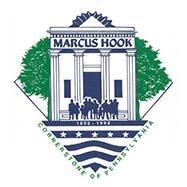Did You Know?
Marcus Hook is one of the earliest settlements in America and the third oldest town.
The Marcus Hook area of the Delaware River waterfront has attracted settlement since the movement of the Lenni Lenape into this region. Reputedly, the town derives its name from an early Finnish settler who resided in a Swedish trading outpost and colonization site in the late 1630's or early 1640's. His given name was Marcus. The word “Hook” meant a point of land and presumably referred to the natural harbor formed below Marcus Hook Creek.
Jump forward to the 1890's. Marcus Hook, then a part of Chichester Township, began to sense its opportunities to rise as an industrial city, creating a unique blend of big city industries and small town life. In 1892 the first trolly came to town, the town was wired for telephones and electric power. Ship yards thrived along the waterfront next to Lindenthorpe Park where, among other leisure time activities, horse races were held. From the docks, a person could take a steamboat to other ports, hunt for rail bird or catch perch on the Delaware.
During the past 125 years, 21 men have been leaders of the Borough, having served as Chief Burgess, Burgess, and Mayor.
William Bucknell, the benefactor of Bucknell University in Lewisburg, Pennsylvania, was born in Marcus Hook on April 1, 1811.
The Pennsylvania boundary with New Jersey is located in the middle of the Delaware River.
The Delaware River shoreline in Marcus Hook is 5,780 feet (1.1 miles).
The Lindenthorpe Mansion, built in 1723 near Delaware Avenue and Green Street served as the headquarters for a large riverside amusement park which opened in 1896. The Sun Oil Company purchased the property in 1901.
The first Ordinance adopted by Borough Council on July 1, 1892, prohibited cattle, horses, sheep, swine or goats from running at large upon the streets and open lots within the Borough.
The land upon which old St. Martin’s Church and Cemetery stands was donated by Walter Martin in a deed dated 1699. In consideration of the gift the church canonized him and named the church St. Martin
The boundary line dividing Marcus Hook from the state of Delaware is part of the infamous “Twelve Mile Circle” (originally drawn at a twelve-mile radius from a point in New Castle). It is the only state boundary in this country that does not follow a straight course or follow a natural boundary.
The first man-made fiber, rayon, was originally produced and manufactured in Marcus Hook by the American Viscose Company in 1910.
Viscose Village, constructed between 1907-1911, consisted of 261 dwellings, 2 boarding houses, a village store, and a dining hall/recreation building. These buildings remain intact today.
In 1941, in order to justify providing assistance to Great Britain through the Lend-Lease Program, the United States government forced the sale of Britain’s largest, most profitable U.S. holding, the American Viscose Company of Marcus Hook, to U.S. bankers for $62.3 million, a fraction of its worth, to prove to a skeptical U.S. public that England – besieged in Europe, and “blitzed” by Germany – needed help.
There are five states in the nation that include “boroughs” in their systems of local government, but only New Jersey is similar in its concept of a borough to what exists here in Pennsylvania. Both are close to the British common law notion of a borough, with a weak mayor/strong council system of government. However, New Jersey has only about 200 boroughs, while Pennsylvania has 958. In Alaska, a borough is more like a county is here in Pennsylvania, with more of a regional than a local focus. In New York, a borough is a subdivision of a city. In Connecticut, a borough is an incorporated portion of a town, and provides some services exclusively in its area, but is subordinate to the government of the town of which it is a part.
Market Square Memorial Park was the first municipally owned riverfront park in Delaware County and remains only one of two today.
Marcus Hook is the warmest place in Pennsylvania. Marcus Hook averages 78 in July and 33 in January. It receives less than 20 inches of snow a year, and freezing temperatures are rarely felt before mid-November or after late March.


